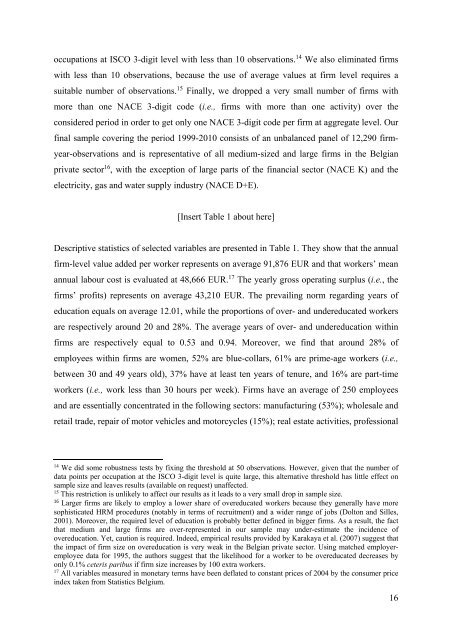CEB Working Paper
240798&r=lma
240798&r=lma
Create successful ePaper yourself
Turn your PDF publications into a flip-book with our unique Google optimized e-Paper software.
occupations at ISCO 3-digit level with less than 10 observations. 14 We also eliminated firms<br />
with less than 10 observations, because the use of average values at firm level requires a<br />
suitable number of observations. 15 Finally, we dropped a very small number of firms with<br />
more than one NACE 3-digit code (i.e., firms with more than one activity) over the<br />
considered period in order to get only one NACE 3-digit code per firm at aggregate level. Our<br />
final sample covering the period 1999-2010 consists of an unbalanced panel of 12,290 firmyear-observations<br />
and is representative of all medium-sized and large firms in the Belgian<br />
private sector 16 , with the exception of large parts of the financial sector (NACE K) and the<br />
electricity, gas and water supply industry (NACE D+E).<br />
[Insert Table 1 about here]<br />
Descriptive statistics of selected variables are presented in Table 1. They show that the annual<br />
firm-level value added per worker represents on average 91,876 EUR and that workers’ mean<br />
annual labour cost is evaluated at 48,666 EUR. 17 The yearly gross operating surplus (i.e., the<br />
firms’ profits) represents on average 43,210 EUR. The prevailing norm regarding years of<br />
education equals on average 12.01, while the proportions of over- and undereducated workers<br />
are respectively around 20 and 28%. The average years of over- and undereducation within<br />
firms are respectively equal to 0.53 and 0.94. Moreover, we find that around 28% of<br />
employees within firms are women, 52% are blue-collars, 61% are prime-age workers (i.e.,<br />
between 30 and 49 years old), 37% have at least ten years of tenure, and 16% are part-time<br />
workers (i.e., work less than 30 hours per week). Firms have an average of 250 employees<br />
and are essentially concentrated in the following sectors: manufacturing (53%); wholesale and<br />
retail trade, repair of motor vehicles and motorcycles (15%); real estate activities, professional<br />
14<br />
We did some robustness tests by fixing the threshold at 50 observations. However, given that the number of<br />
data points per occupation at the ISCO 3-digit level is quite large, this alternative threshold has little effect on<br />
sample size and leaves results (available on request) unaffected.<br />
15<br />
This restriction is unlikely to affect our results as it leads to a very small drop in sample size.<br />
16<br />
Larger firms are likely to employ a lower share of overeducated workers because they generally have more<br />
sophisticated HRM procedures (notably in terms of recruitment) and a wider range of jobs (Dolton and Silles,<br />
2001). Moreover, the required level of education is probably better defined in bigger firms. As a result, the fact<br />
that medium and large firms are over-represented in our sample may under-estimate the incidence of<br />
overeducation. Yet, caution is required. Indeed, empirical results provided by Karakaya et al. (2007) suggest that<br />
the impact of firm size on overeducation is very weak in the Belgian private sector. Using matched employeremployee<br />
data for 1995, the authors suggest that the likelihood for a worker to be overeducated decreases by<br />
only 0.1% ceteris paribus if firm size increases by 100 extra workers.<br />
17<br />
All variables measured in monetary terms have been deflated to constant prices of 2004 by the consumer price<br />
index taken from Statistics Belgium.<br />
16


